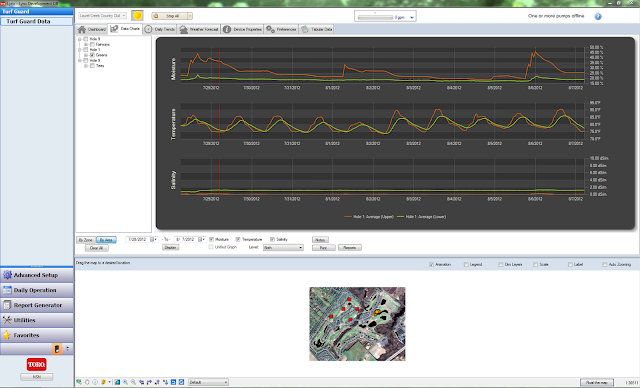After
dealing with some significant thinning of several greens the past two summers
caused by etiolation, we got through 2012 with minimal turf damage. How? Well,
it certainly was not because of a lack of weather-related stress on the turf,
as July tied or broke several heat records.
First, what exactly is etiolation?
Basically,
the symptoms of etiolation in turf are thin, pale and elongated plants, similar
to what you’d see in white asparagus. Eventually,
the weakened turf can collapse and die. On
putting greens, samples exhibiting these symptoms also tend to have high
bacteria counts, which can clog the plant’s "blood stream." This is where the debate among members of the
scientific community occurs: Is the bacteria
a cause of the etiolation and subsequent wilt, or merely a secondary pathogen,
that is taking advantage of an already weakened plant?
Whether
the bacteria is a cause or effect, is not important from our perspective. Regardless of the actual cause, preventing,
controlling, and managing etiolation has become the goal. With that in mind, over the past two years we’ve
worked at developing a set of best management practices in dealing with
etiolation in the greens by researching countless articles, attending seminars,
discussing the issue with other course managers, consultants and scientists from
around the country, and even offered the use of our practice green for a USGA
funded study.
A possible solution
One
plant pathologist believes there is a connection between the occurrence of
etiolation and turf fertility. While we
have always kept the greens fairly lean, his recommendation was to cut back on the
amount of Nitrogen applied even further.
This seems to have been a key.
However,
this method is not without some risk.
Because a putting green is built largely out of sand, which has little
nutrient holding capacity, as we entered the summer, it was like sending a
marathon runner off to race without having a good carbohydrate supply to use
for energy--essentially, the turf got the equivalent of an occasional sports
drink to make it through the summer. To put this into perspective, your home lawn
would typically receive 1 lb. of Nitrogen /1,000 square feet per application of
fertilizer. While applying that much
Nitrogen to a putting green in-season would never be a wise idea, we are now
applying a miniscule rate of 0.03 lb./1,000 square feet.
Counterintuitive measures
In
addition to this lean fertility program, we also stayed very aggressive with
our mowing and rolling regimen throughout the summer. Raising the height of cut is a well
documented way of decreasing plant stress, but we chose not to do that. And, from June 6 through August 13, the
greens were mowed a minimum of once (and often twice) per day, every day. The idea behind these decisions was that
etiolation is much like a plant growing out of control. If we didn’t mow every day, there was a high
likelihood that we would "scalp" the turf when we resumed mowing.
When
you step back and look at some of the practices, they are counterintuitive to
maintaining a healthy green, and so go against some of the rules of thumb of
how to decrease plant stress. For
example, mowing is a stress on the turf.
And yet, in this case, if we chose not to mow, an even greater physical injury
to the plant would occur. So how do you
stop etiolation? In our case, the answer
seems to be, by not managing the turf in a conventional manner.
Looking ahead
As
we near the end of summer, we can exhale a bit as the turf is enjoying cooler
nights, and recovering well. However, Mother
Nature always has some new tricks for us, so we need to continue to research
and understand the causes and the solutions to etiolation, as well as the many
other enemies of good turf, that would try to keep all of us from enjoying the
beauty of a great day on the greens.
 |
| In this picture from 2011, patches of etiolated Bentgrass can be seen in the collar. |
.JPG)









.JPG)
.JPG)


.JPG)









.JPG)











.JPG)


